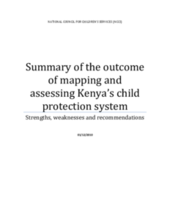Background and Situation analysis
Governments and international organizations are increasingly turning to what is referred to as a systems approach in order to establish and otherwise strengthen comprehensive child protection efforts. As guided by the Convention on the Rights of the Child (CRC), the systems approach differs from earlier child protection efforts, which have traditionally focused on single issues, such as child trafficking, street children, child labor, emergencies, institutionalization, and HIV/AIDS, among others. Although such efforts have produced substantial benefits, this approach often results in a fragmented child protection response. Establishing or strengthening a child protection system requires attention to legal and policy reforms, institutional capacity development, planning, budgeting, monitoring and information systems.
Several actors in Kenya, including National Council for Children’s Services (NCCS) and African Network for Prevention and Protection against Child Abuse and Neglect (ANPPCAN) Regional Office, have for years advocated for the establishment of a child protection system that prevents and responds to violence, abuse and exploitation of children or family separation, both during times of relative normality and during emergencies. Furthermore, the Ministry of Gender, Children and Social Development (MoGCSD) has included the need for developing a functional child protection system for Kenya in its Strategic Plan 2008- 2012.
In 2009, UNICEF HQ, as part of an organization-wide endeavour to initiative systems development globally, contracted Maestral International to develop a practical and user-friendly tool for mapping and assessing child protection systems at a national level. At the same time, UNICEF also contracted Chapin Hall at the University of Chicago, with the American Humane Association to review academic and professional literature on systems, with the aim of obtaining conceptual clarity on what a child protection system is.
The toolkit provides a framework for:
- identifying a country’s child protection risks;
- identifying the existing rights framework;
- the scope and capacity of both the formal and the informal sectors to prevent and respond to child protection issues at national down to community level;
- accountability mechanisms; and
- resource mobilisation approaches.
The purpose of the toolkit is to help UNICEF country teams and their partners to enhance the overall child protection dialogue and programming, with a particular focus on developing system capacity.
Kenya has been one of the pilot countries to complete the toolkit. This process started in October 2009 when a meeting was held in Naivasha. Representatives from line ministries, NGOs and civil society provided input and comments on the global toolkit. Some attempts were made to adjust the toolkit into the Kenyan context. It was agreed at the meeting that a taskforce should be established under NCCS, and be chaired by ANPPCAN. The taskforce was to second the members and lead the process in filling out the toolkit.
Four workshops have been held, at which the participants filled in the toolkit. The participants were representatives from line ministries and civil society. The workshops were divided into four areas: the justice sector; social services; continuum of care; and civil society. This division reflects the outline of the toolkit. The aim was to define a minimum package of child protection laws, services and capacities that are considered necessary to establish a functioning child protection system.
To ensure that children’s views and experiences of the child protection system were captured, Save the Children Alliance contracted Emkay East Africa Limited to conduct a study with children. Approximately 800 children, between the ages of 7-21, were interviewed in Molo, Butere, Dadaab, Kisumu, Thika, Nyahururu, Mombasa and Nairobi. The particular objectives of the exercise were:
• to establish the level of awareness by children of the existence of child protection systems in Kenya;
• to assess the level of participation of children on issues and policies that affect them;
• to assess the effectiveness of existing services for children; and
• to establish the most accessible structures for child protection at community, locational and district level.
The findings of the study with children are incorporated in this summary document.
A preliminary validation workshop was held in April 2010, with the aim to present the outcome of the children’s views, and to validate the information gathered in the toolkit, including strengths and major gaps of the system. This paper provides a summary of the outcome of these processes, including the current strengths, weaknesses and gaps of Kenya’s child protection system.

